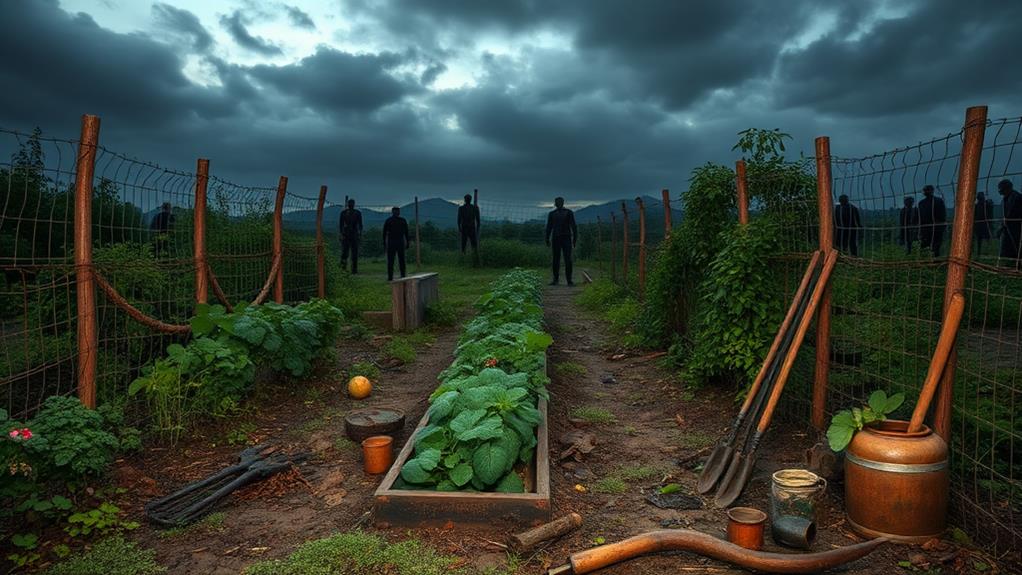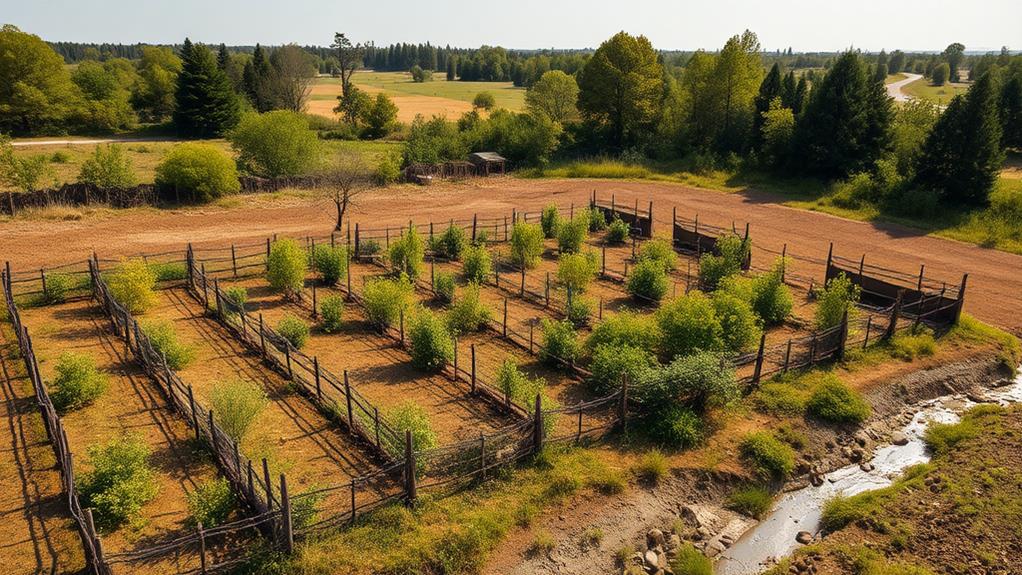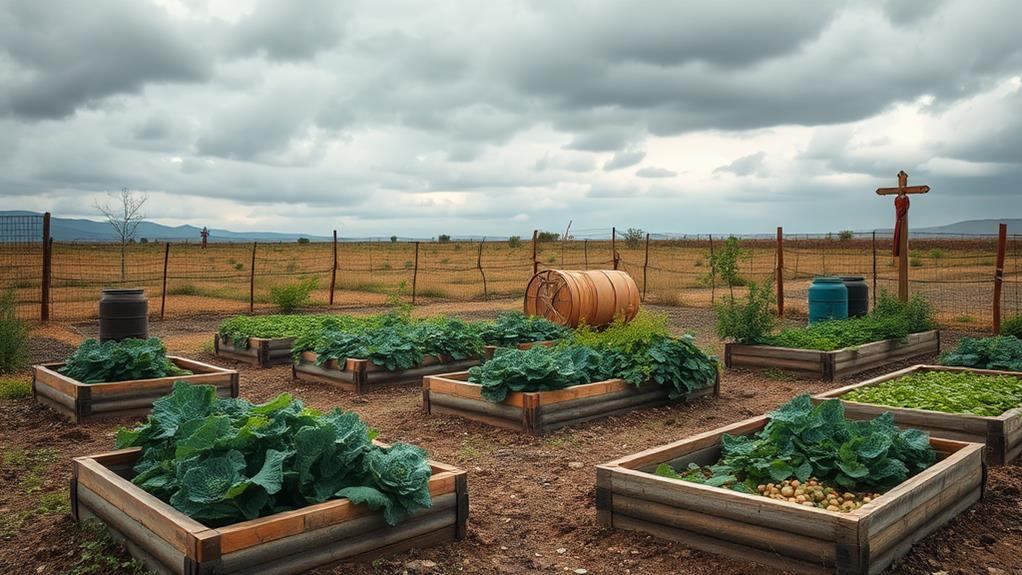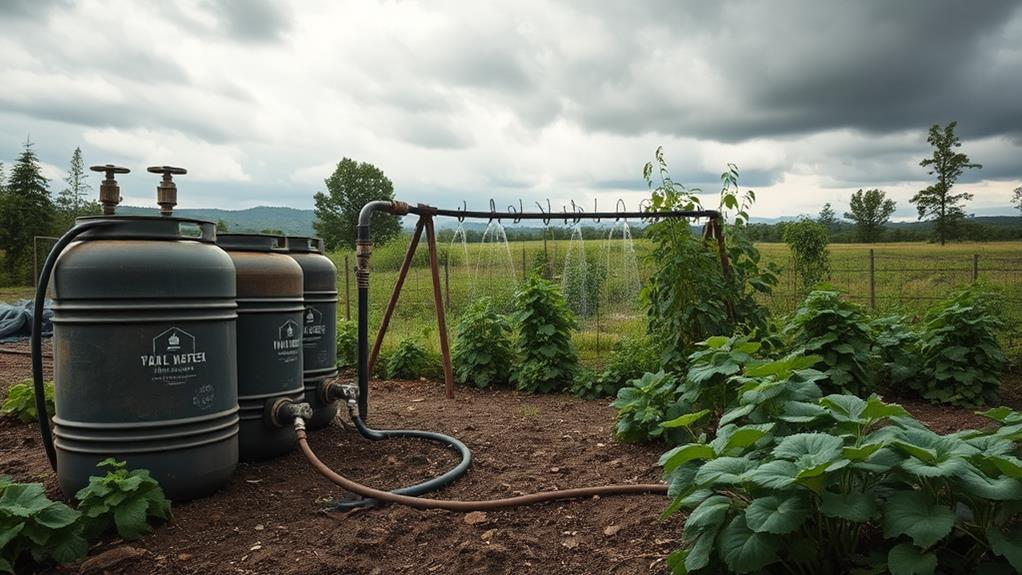
To grow food during a zombie apocalypse, start by choosing a safe and defensible location like a rooftop or walled garden with ample sunlight and good soil. Gather essential tools, protective measures, and scavenge for supplies. Plant resilient crops such as root vegetables, legumes, and hardy herbs to maximize nutrition. Prepare the soil by clearing debris, testing pH levels, and adding compost. Collect rainwater, mulch, and set up a drip irrigation system to conserve water. Finally, protect your garden with sturdy fencing, noise traps, and a guard rotation. Stick around, there's more to guarantee your garden thrives in these perilous times.
Choosing the Right Location

How do you find the perfect spot to grow food when the undead are roaming around? First, you need to prioritize safety. Look for an area that's easily defensible, like a rooftop or a walled garden. High ground reduces the risk of zombie encounters and gives you a clear view of your surroundings.
Next, consider sunlight. Your crops need at least six hours of sunlight daily. Scout locations that aren't shaded by buildings or trees. Also, check the soil quality. Rich, loamy soil is ideal, but if that's hard to find, look for places where the ground is fertile enough to support plant life.
Water access is vital. You might not have running water, so proximity to a natural water source like a stream or pond is beneficial. Make sure you can set up a rainwater collection system if needed.
Lastly, think about proximity to your shelter. You don't want to travel far to tend your crops, exposing yourself to danger. The closer your garden is to where you sleep, the easier it is to monitor and protect.
Essential Tools and Supplies
Once you've secured the perfect location for your garden, it's time to gather the necessary tools and supplies. Having the right gear will make your gardening efforts more efficient and increase your chances of success.
- Hand Tools: A sturdy set of hand tools, including a trowel, hand fork, and pruning shears, is indispensable. These tools will help you plant seeds, manage soil, and prune plants.
- Watering Equipment: Whether it's a watering can, hose, or drip irrigation system, ensuring your plants get enough water is vital. Collect rainwater if possible to conserve resources.
- Soil Amendments: Quality soil is the foundation of a healthy garden. Gather compost, manure, and mulch to enrich your soil and improve its structure.
- Protective Measures: Safeguard your crops from pests and harsh weather with items like row covers, garden fencing, and organic pest control sprays.
Don't forget to repurpose and scavenge for supplies. Old containers can become planters, and natural materials like leaves and grass clippings can be used as mulch. By assembling these essential tools and supplies, you'll be well-prepared to cultivate a thriving garden during the zombie apocalypse.
Selecting Resilient Crops

When facing the challenges of a zombie apocalypse, choosing resilient crops is crucial for your survival. You'll want to focus on plants that can withstand rough conditions, require minimal care, and yield high nutrition. Root vegetables like carrots, potatoes, and sweet potatoes are excellent choices. They're hardy, store well, and provide essential nutrients.
Legumes, such as beans and lentils, are another must-have. They're protein-packed and can enrich the soil with nitrogen, which benefits other plants. Leafy greens, like kale and spinach, grow quickly and are nutrient-dense, giving you essential vitamins and minerals.
Consider perennial crops like asparagus and rhubarb. These plants come back year after year, reducing the need for replanting. Hardy herbs like rosemary, thyme, and oregano are also valuable. They add flavor to your meals and have medicinal properties.
Soil Preparation Techniques
Preparing your soil properly is the foundation of a successful zombie apocalypse garden. You can't afford to waste time and resources on unproductive soil, so let's get it right from the start. First, clear the area of any debris or remnants from the pre-apocalypse world. Remove rocks, trash, and dead plants to create a clean slate for your new garden.
Next, you'll want to test your soil's pH levels. An ideal range for most crops is between 6.0 and 7.0. If you don't have a pH tester, you can use a simple DIY vinegar and baking soda test. Here's what you need to do:
- Collect soil samples: Gather soil from different spots in your garden.
- Test with vinegar: Add vinegar to one sample. If it fizzes, your soil is alkaline.
- Test with baking soda: Add water and baking soda to another sample. If it fizzes, your soil is acidic.
- Adjust pH: Add lime to raise pH or sulfur to lower it, based on your tests.
Once you've balanced your soil's pH, mix in compost and organic matter. This enriches the soil and improves its structure, ensuring your crops get the nutrients they need to thrive, even in a post-apocalyptic world.
Watering and Irrigation

Watering and irrigating your crops in a zombie apocalypse requires careful planning and resourcefulness. You'll need to maximize every drop of water, as access to clean water might be limited. First, collect rainwater using any available containers like barrels, buckets, or even makeshift tarps. Place these strategically to capture as much water as possible during rainfall.
Next, consider setting up a simple drip irrigation system. Poke small holes in a hose or plastic bottles placed near plant roots. This method guarantees that water goes directly to where it's needed most, minimizing waste. If you have access to a nearby stream or pond, utilize a hand pump or a gravity-fed system to transport water to your crops.
Water your plants early in the morning or late in the evening to reduce evaporation loss. Mulch around your plants with leaves, straw, or grass clippings to help retain soil moisture. Be mindful of the types of crops you choose; drought-resistant varieties can thrive with less water.
Protecting Your Garden
Your garden's survival hinges on effective protection strategies, especially during a zombie apocalypse. You can't afford to lose your precious crops to zombies or other scavengers.
- Build a Sturdy Fence: Construct a tall, solid fence around your garden. Use materials like wood, metal, or even debris if necessary. The fence should be at least 8 feet high to deter zombies and other intruders.
- Set Up Traps: Install noise-making traps around the perimeter. These can be as simple as cans tied to string or more complex like tripwire alarms. The noise will alert you to any approaching threats and give you time to react.
- Camouflage Your Garden: Hide your garden from plain sight. Use natural elements like bushes, trees, or even old tarps to conceal it. The less visible it is, the less likely zombies or other survivors will find it.
- Guard Duty: Establish a rotation schedule for garden watch. Having someone on guard at all times guarantees prompt response to any threats. Equip them with necessary tools for defense, such as a bow or a sturdy spear.
At a Glance
In a zombie apocalypse, growing your own food isn't just about survival; it's about resilience. Take Sarah, who transformed her rooftop into a thriving vegetable garden. With proper planning, tools, and crop choices, you can guarantee a steady food supply. Remember, the key lies in choosing the right location, preparing the soil, and protecting your garden. Your efforts will pay off, turning a dire situation into a sustainable future. Don't just survive – thrive.






